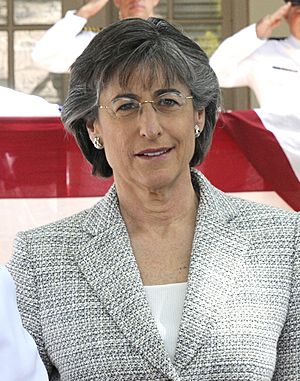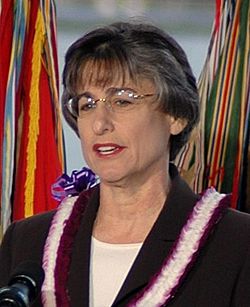Linda Lingle facts for kids
Quick facts for kids
Linda Lingle
|
|
|---|---|

Lingle in 2010
|
|
| 6th Governor of Hawaii | |
| In office December 2, 2002 – December 6, 2010 |
|
| Lieutenant | Duke Aiona |
| Preceded by | Ben Cayetano |
| Succeeded by | Neil Abercrombie |
| Chair of the Hawaii Republican Party | |
| In office January 2, 1999 – December 2, 2002 |
|
| 3rd Mayor of Maui | |
| In office January 2, 1991 – January 2, 1999 |
|
| Preceded by | Hannibal Tavares |
| Succeeded by | Kimo Apana |
| Personal details | |
| Born |
Linda Cutter
June 4, 1953 St. Louis, Missouri, U.S. |
| Political party | Republican |
| Spouses |
Charles Lingle
(m. 1972; div. 1975)William Crockett
(m. 1986; div. 1997) |
| Education | California State University, Northridge (BA) |
| Signature | |
Linda Lingle (born Linda Cutter on June 4, 1953) is an American politician who was the sixth Governor of Hawaii. She served from 2002 to 2010. As a member of the Republican Party, she made history in several ways. She was the first Republican to be elected governor of Hawaii in over 40 years. She was also the state's first female governor and its first Jewish governor.
Before becoming governor, Lingle was the mayor of Maui County from 1991 to 1999. She also led the Hawaii Republican Party. As of 2025, Lingle and her lieutenant governor, Duke Aiona, are the last Republicans to have held a statewide office in Hawaii.
After her time as governor, Lingle ran for the U.S. Senate in 2012 but was not elected. She later worked as an adviser to the governor of Illinois and served on the boards of several organizations, including Hawaii Pacific University.
Contents
Early Life and Career
Linda Lingle was born Linda Cutter in St. Louis, Missouri. Her family was Jewish. When she was 12, her family moved to Southern California. She graduated from California State University, Northridge in 1975 with a degree in journalism.
After college, she moved to Hawaii. She first worked for a workers' union in Honolulu. Later, she moved to the island of Molokai. There, she started her own community newspaper called the Molokai Free Press.
Political Beginnings in Maui
In 1980, Lingle's political career began when she was elected to the Maui County Council. She served on the council for ten years.
In 1990, she ran for mayor of Maui County. Many people thought she would lose, but she won the election. This was seen as a major upset in Hawaii politics. At 37, she became the youngest mayor of Maui County and the first woman to hold the job. She was re-elected in 1994.
As mayor, Lingle was known for her work on the county's budget. She also helped bring more tourism and jobs to Maui when other parts of Hawaii were struggling.
Running for Governor
1998 Election
In 1998, Lingle ran for governor of Hawaii against the current governor, Benjamin J. Cayetano. She focused on improving Hawaii's economy. The election was extremely close. After all the votes were counted, Lingle lost by a very small margin in one of the closest races in Hawaii's history.
After the election, Lingle became the chair of the Hawaii Republican Party from 1999 to 2002. She worked to make the party stronger and attract new members.
2002 Election Victory
Lingle ran for governor again in 2002. This time, her opponent was the Democratic lieutenant governor, Mazie Hirono. Lingle's campaign focused on bringing new ideas and changes to the state government.
She won the election and became Hawaii's sixth governor. Her running mate, Duke Aiona, became the lieutenant governor. Lingle was sworn into office at the Hawaii State Capitol.
Governor of Hawaii (2002–2010)
As governor, Lingle signed several new laws. She was known for having high approval ratings from the public, often around 70 percent.
In 2004, she campaigned for President George W. Bush and other Republican candidates. She hoped to help Republicans win in Hawaii, but the state voted for the Democratic candidate, John Kerry.
Re-election in 2006
Lingle ran for re-election in 2006. Her Democratic opponent was former state senator Randy Iwase. Lingle won the election easily, with 63 percent of the vote. It was the largest victory margin for a governor in Hawaii's history.
Second Term Highlights
During her second term, one major issue was the Hawaii Superferry. This was a large, high-speed ferry service between the islands. A court ruled that the company needed to study the ferry's impact on the environment. Lingle and the state government passed a special law to allow the ferry to operate anyway.
However, the Hawaii Supreme Court later said this law was unconstitutional. The Superferry stopped its service in Hawaii in 2009.
In 2008, Lingle spoke at the 2008 Republican National Convention. She supported John McCain for president and praised his choice of Sarah Palin as his running mate.
In 2010, Lingle vetoed a bill that would have allowed civil unions in Hawaii. She said that such an important issue should be decided by the voters in a special election, not by the legislature.
Life After Being Governor
Lingle could not run for a third term as governor. She left office in 2010.
2012 Senate Election
In 2011, Lingle announced she would run for the U.S. Senate. She won the Republican primary election. In the general election, she faced Mazie Hirono, the same opponent from her 2002 governor's race. This time, Hirono won the election.
Recent Work
After her Senate campaign, Lingle taught at her old university, California State University, Northridge. In 2015, she became a senior adviser to Illinois Governor Bruce Rauner. She left that job in 2016.
Lingle moved back to Hawaii in 2017. She joined the board of trustees for Hawaii Pacific University. She has also been involved in projects to help women leaving prison and has supported local political candidates.
Personal Life
Linda Lingle has been married and divorced twice. She does not have any children. Her uncle founded the Cutter Ford car dealerships in Hawaii.
She is an active member of the Republican Jewish Coalition. In 2008, President George W. Bush asked her to join him on a trip to Jerusalem to celebrate the 60th anniversary of Israel.
Electoral history
| Party | Candidate | Votes | % | |
|---|---|---|---|---|
| Democratic | Ben Cayetano (incumbent) | 204,206 | 50.11 | |
| Republican | Linda Lingle | 198,952 | 48.82 | |
| Libertarian | George Peabody | 4,398 | 1.08 | |
| Total votes | 407,556 | 100.00 | ||
| Democratic hold | ||||
| Party | Candidate | Votes | % | |
|---|---|---|---|---|
| Republican | Linda Lingle | 194,338 | 52.31 | |
| Democratic | Mazie Hirono | 177,186 | 47.69 | |
| Total votes | 371,524 | 100.00 | ||
| Republican gain from Democratic | ||||
| Party | Candidate | Votes | % | |
|---|---|---|---|---|
| Republican | Linda Lingle (incumbent) | 215,313 | 63.89 | |
| Democratic | Randy Iwase | 121,717 | 36.11 | |
| Total votes | 337,030 | 100.00 | ||
| Republican hold | ||||
| United States Senate election in Hawaii, 2012 | |||||
|---|---|---|---|---|---|
| Party | Candidate | Votes | % | ±% | |
| Democratic | Mazie Hirono | 269,489 | 62.60% | +1.25% | |
| Republican | Linda Lingle | 160,994 | 37.40% | +0.62% | |
| Total votes | 430,483 | 100.00% | N/A | ||
| Democrat hold | |||||
See also
 In Spanish: Linda Lingle para niños
In Spanish: Linda Lingle para niños



